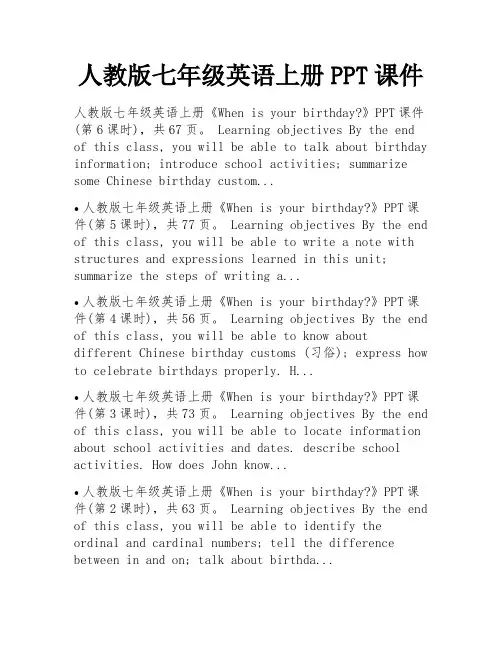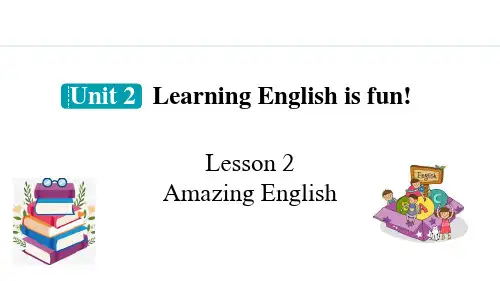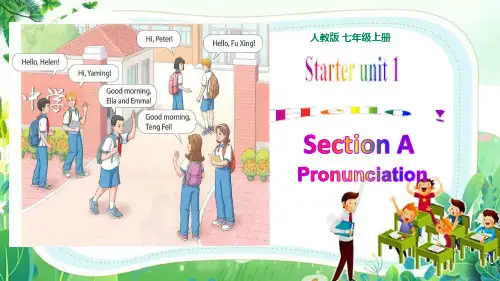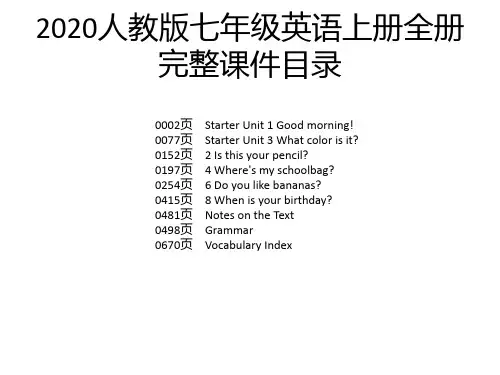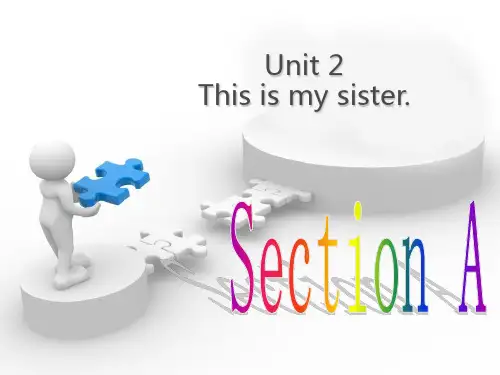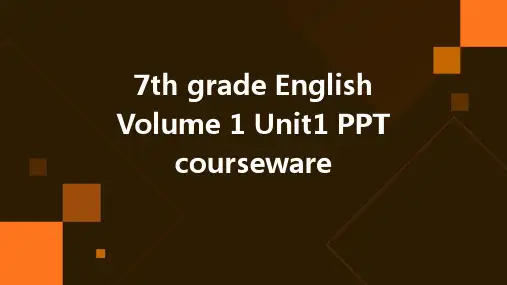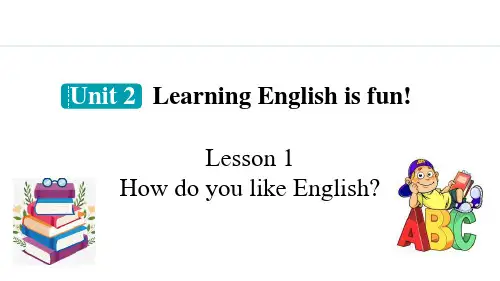- 1、下载文档前请自行甄别文档内容的完整性,平台不提供额外的编辑、内容补充、找答案等附加服务。
- 2、"仅部分预览"的文档,不可在线预览部分如存在完整性等问题,可反馈申请退款(可完整预览的文档不适用该条件!)。
- 3、如文档侵犯您的权益,请联系客服反馈,我们会尽快为您处理(人工客服工作时间:9:00-18:30)。
Unit3. This is my sister. 句型: No, it isn’t. 句型:1,Is this your sister? Is she your sister? No, she isn’t. 2,This is my friend. These are my friends. That is my brother. Those are my brothers. 3, Thanks for the photo of your family. Here is my family photo. photo of your family = your family photo 语法:可数名词单数变复数: 语法:可数名词单数变复数: 一般情况下加s, 结尾的加es 一般情况下加 book-books, 以s, x, sh, ch结尾的加 , 结尾的加 watch-watches 以辅音字母加 结尾的,把y改为 再加 以辅音字母加y结尾的 结尾的, 改为i再加 改为 再加es boy- boys, family-families 结尾的有生命的加es, 无生命的加 无生命的加s, 以o结尾的有生命的加 结尾的有生命的加 tomato-tomatoes, photo-photos
Unit2. Is this your pencil? 句型: 句型:1, Is this your pencil? Yes, it is. 2, Is this my pen? No, it isn’t. 3, Is that his book? Yes, it is. 4, How do you spell it? = Can you spell it, please? = Spell it, please. 5, Call Alan at 495-3539. Call me/him/her/them. 给我/他 她 他们打电话 他们打电话. 给我 他/她/他们打电话 Call sb. at + 电话号码 拨打 拨打……找某人 找某人 6, Is that your computer game in the lost and found case? 7, a set of keys a set of + 名词复数 语法; 句中含 句中含be(am, is, are)一般疑问句的变法: 一般疑问句的变法: 语法;1,句中含 一般疑问句的变法 提前, 把be提前,如果句中有 变your,I 变you,其他的照抄不变。 提前 如果句中有my变 , ,其他的照抄不变。 主语+am/is/are 否定回答 No,主语 主语+am not/aren’t/isn’t. 肯定回答 yes, 主语 主语 注意:回答时主语如果是物品单数或者this/that的话, 的话, 注意:回答时主语如果是物品单数或者 的话 替代主语, 替代。 用it替代主语,如果是复数人和物品用 替代主语 如果是复数人和物品用they替代。 替代 2, be动词的用法口诀;I am, you are, is 他/她/它(he/she/it), 动词的用法口诀; 动词的用法口诀 她它 ) 单数is 复数are. Be动词跟随主语的变化而变化。 动词跟随主语的变化而变化。 单数 复数 动词跟随主语的变化而变化
unit6 Do you like bananas? 句型: 句型:Do you like salad? Yes, I do./No, I don’t. Does he like pears? Yes, he does./No, he doesn’t. I like oranges. I don’t like oranges. Running star eats lots of healthy food. 语法: 句中谓语动词是实义动词的陈述句, 语法 句中谓语动词是实义动词的陈述句,变否定 形式在实义动词前加don’t\doesn’t(主语是第三人 形式在实义动词前加 主语是第三人 称单数时用doesn’t’). 称单数时用 like doing sth/like to do sth 喜欢做某事 I like swimming. She likes to eat hamburgers.
unit4. Where’s my backpack? 句型: It’s in the backpack. 句型:Where’s the baseball? Where’s my computer game? It’s under the bed. Where are his keys? They’re on the dresser. Where are your books? They’re on the chair. Where are her keys? They’re on the table. Where are you? I’m at school. Is it on the dresser? No, it isn’t. Please take these things to your sister. Can you bring some things to school? The book is on the floor.
语法: 询问人或物品在哪里 我们用Where, 结构为 询问人或物品在哪里, 语法 1,询问人或物品在哪里,我们用 where+is/are+人/物品名称 “……在哪里” 回答用 主语 物品名称? 在哪里” 人 物品名称 在哪里 +is/are +in/at/under/on/near +地点 地点 注意:表示“ 地方” 注意:表示“在……地方”地点前要用定冠词 地方 地点前要用定冠词the 或者形容词 性物主代词my/your/his/their修饰,但是两者不能同时出现, 性物主代词 修饰,但是两者不能同时出现, 修饰 我们可以说in 但是绝对不可以in 我们可以说 the room, in my room 但是绝对不可以 the my room. 词语用法:1, 带走, 词语用法 take v.带走, 把人或物品带到别的地方去, 带走 把人或物品带到别的地方去, take … to… 把……带到 带到……去 带到 去 bring v.带来,把人或物品从别的地方带到说话的地方 带来, 带来 带到……来 来 bring…to… 把……带到 带到 来 2,please 后接动词用原形。 后接动词用原形。
Unit1. My name’s Gina. 句型: 句型:1, What’s your name? My name’s Jenny. / I’m Jenny. / Jenny. May I have your name?Yes, my name’s Jenny. What’s his/her name? His/Her name’s Tony/Gina. 2, I’m Tony Brown. My first name is Tony. My last name/family name is Brown. 3, What’s your/his/her telephone/phone number? It’s 555-3539. 语法:1,形容词性物主代词: 语法: 形容词性物主代词: 形容词性物主代词 my(我的 your(你的 his/her/its(他/她/它的 我的) 你的) 它的) 我的 你的 他 她 它的 our(我们的 your(你们的)their(他们的) 我们的) 你们的) 他们的) 我们的 你们的 他们的 后面需要接名词,修饰名词,做前置定语。 后面需要接名词,修饰名词,做前置定语。 在句中可作主语,宾语等成分。 在句中可作主语,宾语等成分。 My book is here. This is my book. 2, 主格: I 主格: you he/she/ it we you they 在句中做主语,一般放句首, 及其他动词。 在句中做主语,一般放句首,后面紧跟 am/is/are 及其他动词。 I’m a student. She looks great.
unit5. Do you have a soccer ball? 句型: Yes, I do/No, I don’t. 句型 Do you have a TV? Do they have a computer? Yes, they do./No, they don’t. Does he have a tennis racket? Yes, he does./No, he doesn’t. Does she have a soccer ball? Yes, she does./No, she doesn’t. Does he have a ping-pang ball? Yes, he does./No, he doesn’t. Let’s play soccer. Let me help you. I don’t have a soccer ball. That sounds good.……
语法: 句中不含 句中不含be(am,is,are)动词的 一般疑问句的变法。 也就是说句中谓语 语法:1,句中不含 动词的 一般疑问句的变法。 动词是实义动词时,要变为一般疑问句,在句首加do/does(当主语是第三人称 动词是实义动词时,要变为一般疑问句,在句首加 ( 单数的时候用does),第一人称变第二人称,动词变原形其他的语序不变。I 第一人称变第二人称, 单数的时候用 ) 第一人称变第二人称 动词变原形其他的语序不变。 have a computer. – Do you have a computer? She likes playing pingpang.- Does she like playing ping-pang.肯定回答用 肯定回答用yes, 主语 主语+do/does.否定 肯定回答用 否定 回答用No,主语 主语+don’t/doesn’t. 回答用 主语 2一般句子中当主语是第三人称单数的时候,谓语动词要起变化。具体的变 一般句子中当主语是第三人称单数的时候, 一般句子中当主语是第三人称单数的时候 谓语动词要起变化。 化为:一般情况加s, 结尾的加es, teach-teaches, 化为:一般情况加 know-knows, 以s,x,ch,sh,o结尾的加 结尾的加 go-goes, 以辅音字母加 结尾,把y改为 再加 以辅音字母加y结尾 结尾, 改为i, 改为 再加es study-studies 3,do/does 叫做助动词 语法需要加上去翻译部出来的动词 时,后面接动词 叫做助动词(语法需要加上去翻译部出来的动词 语法需要加上去翻译部出来的动词)时 原形, 原形, Does he like reading? She doesn’t like reading. She doesn’t do her homework. 但是如果做实义动词(能翻译出来意思的动词 能翻译出来意思的动词)呢 但是如果做实义动词 能翻译出来意思的动词 呢,遇到主语第三人称单数 就要起变化。 就要起变化。 She does her homework. 4,have的第三人称单数为 has. , 的第三人称单数为 5, let sb do sth 让某人做某事 (sb代表人,如果是代词用宾格,do代表动 代表人, 代表人 如果是代词用宾格, 代表动 词原形) 词原形) 6,play+球类 表示“踢,打,玩......” play football , 球类 表示“ play+the+乐器 表示“弹奏 乐器” 乐器 表示“弹奏……乐器” play the piano 乐器

